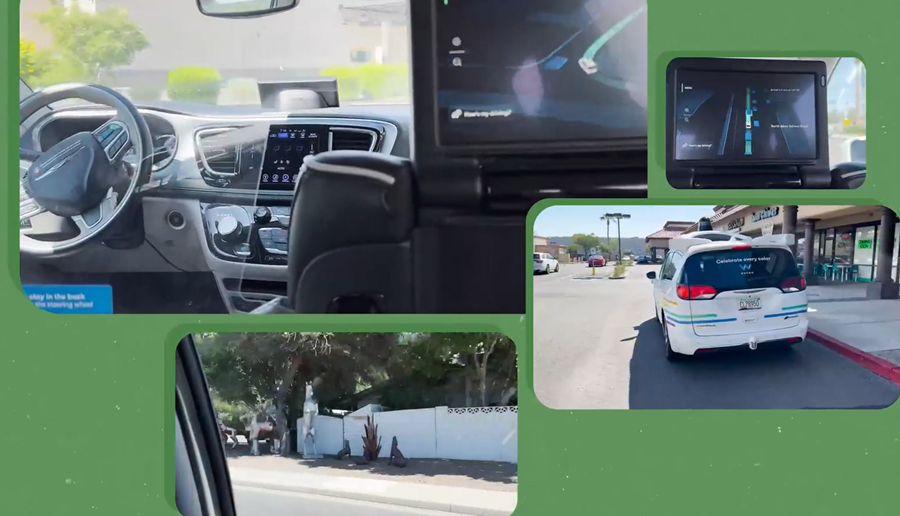One day this month, I finished up some shopping in Chandler, Ariz., a few towns over from a hotel where I was attending a conference. I had a few free hours and I wanted to grab some tacos at a nearby place that had been recommended to me. So I pulled out my phone, opened an app and hailed a ride.
This seems rather a dull story, I hear you say, and, you’re right, except for one thing: The car had no driver.
Since October 2020, the Google spinoff Waymo has operated a driverless commercial taxi service south of Phoenix. Having written about the possibilities of a self-driving future, I wanted to try it out, so I headed over to Chandler and downloaded the Waymo One app. This was no curated demo for journalists, hovered over by anxious engineers and peppy PR folks; I got exactly the same service that you will, if you ever find yourself in Chandler and want to go for a ride in the future.
I warn you that if you do, you will find the future feels almost disappointingly normal.
Not at first, though. At first you experience awe tinged with a bit of fear. There is an undeniable horror-movie aspect to sitting in the back of a car and watching the steering wheel turn of its own accord, and for just a moment I thought, “God, what have I done?” But the car’s ultracautious driving style quickly overcame my reservations, for no Uber driver ever piloted a vehicle so conservatively.
My car waited patiently at the parking lot entrance for a clear break in traffic, rather than trying to force its way into the flow. It slowed when other vehicles behaved erratically and merged with the polite delicacy of a Victorian aunt. It was all so soothing that eventually I got caught up in texting with a colleague and absent-mindedly started to ask the driver how much longer it would be until we got to the restaurant.
Now, of course, most of the time I was aware of my strange situation. I peered over the empty front seat to try to determine whether the gas pedal was moving by itself, like the steering wheel. (Not as far as I could tell.) I laughed as drivers in adjacent lanes did a double take over the missing driver. I goggled at the display that showed me what the car “sees” — the lanes on the road, the other cars, even pedestrians.
But when all that was said and done, it was just a ride, and when people asked me what it was like, all I could say, apologetically, was that it was both supercool and oddly unthrilling.
The most exciting moment occurred when a truck driver in front of us decided he was in the wrong lane and just sat there for a good long time before eventually honking at us to back up so that he could reverse and slide into the lane to our left. Since the car was oblivious to social cues, the result was a standoff. Eventually, the car chirped that it was calling a human specialist to resolve the situation — right around the time that the truck driver apparently decided he had enough room to execute the merge without our help. After a pause to verify that the road was now clear, the car rolled silently on.
As the truck incident suggests, some wrinkles still need to be worked out before the future becomes the present. For one thing, there is a reason that Waymo One is operating in Chandler, with its wide, straight roads, minimal pedestrian traffic and 330 days of sun a year: It reduces the complexities of harsh weather and unpredictable humans. The humans, in particular, are a problem, because for all their advantages (self-driving cars do not get impatient or distracted, intoxicated or exhausted), a 10-year-old human child is probably better at guessing what other people are likely to do when something unexpected happens. The 10-year-old would have understood, for example, that the truck wanted us to back up.
But with that disclaimer out of the way: We are still talking about a technology that could drive on the highway so flawlessly that I got bored enough to let my phone distract me. I feel pretty confident that we’ll slowly solve the remaining problems through some combination of machine learning and human ingenuity — well enough that eventually, the vehicles will become ubiquitous and jaded humans will forget how amazing they actually are.
As I motored around Chandler, I thought of all the problems a really good self-driving car could solve: the accidents it could prevent, the elderly or disabled people it could rescue from isolation. I also wondered what changes it might spark that I can’t imagine — who in 1900 predicted how the automobile would eventually entirely reshape our built environment.
But I was also reminded Waymo’s technology was not actually the only modern marvel I was witnessing. A self-driving car is not, after all, more wondrous than the horseless carriage itself, nor the slender aluminum tube that carried me through the sky so I could witness it. If riding around in the future turned out to be less thrilling than I anticipated, I suspect that’s because really, we already live in the future … and subsist on so many daily miracles that it’s hard to be properly amazed at any of it.
